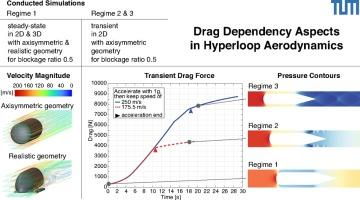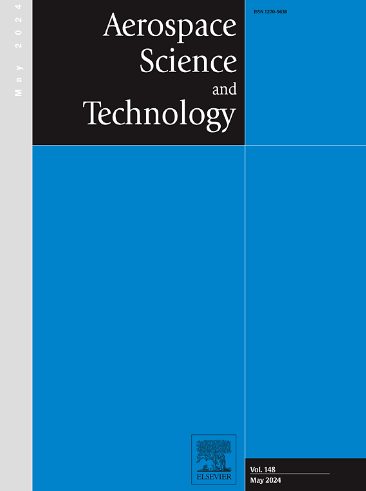超级高铁空气动力学中的阻力依赖性问题
IF 5
1区 工程技术
Q1 ENGINEERING, AEROSPACE
引用次数: 0
摘要
Hyperloop 系统有望成为城市间快速、可持续和经济旅行的可行解决方案。本文通过大量数值模拟研究了 Hyperloop 空气动力学这一具有挑战性的课题。为了有效管理计算资源,研究根据相对于几何康特洛维茨极限的速度进行划分。在此极限以下,即过渡到窒息流时,我们对轴对称二维模型、类似的三维几何图形和阻塞率为 0.5 的现实三维几何图形在几种速度下进行了交叉验证。我们确定了阻力的明确范围,观察到明显较低的绝对阻力值,并对二维轴对称简化进行了深入分析。在窒息流条件之上,我们对二维设置进行了两次资源密集型模拟,加速通过数公里长的管道。通过这种方法,我们得以了解瞬态条件下出现的阻力行为。我们的研究证实了文献中概述的三种状态的存在。尽管如此,分析结果之间仍存在明显差异,主要体现在冲击波结构的配置、匀速时阻力的线性递增以及吊舱加速度曲线对流动结构的影响。本文章由计算机程序翻译,如有差异,请以英文原文为准。

Drag dependency aspects in Hyperloop aerodynamics
The Hyperloop system is promising a viable solution for fast, sustainable, and economic travel between cities.
This paper investigates the challenging topic of Hyperloop aerodynamics via extensive numerical simulations. The study is divided based on the speed relative to the geometric Kantrowitz limit to manage the computational resources effectively. Below this limit, which marks the transition to choked flow, we conducted a cross-validation among an axisymmetric 2D model, a similar 3D geometry, and a realistic 3D geometry for blockage ratio 0.5 at several speeds. A definitive range for drag was determined, notably low absolute drag values were observed, and the 2D axisymmetric simplification was put into perspective.
Above the choked flow condition, we undertook two resource-intensive simulations of the 2D setup, accelerating through several kilometers of tube. This methodology allowed us to shed light on the drag behavior that emerges under transient conditions. The existence of three regimes outlined by literature is corroborated by our study. Nevertheless, distinct variations emerge between the analyses, notably in the configuration of the shock wave structure, the linear increment of drag at a constant velocity, and the influence of the pod's acceleration profile in the flow structure.
The study broadens the understanding of Hyperloop aerodynamics and offers realistic drag data for both choked and non-choked flow.
求助全文
通过发布文献求助,成功后即可免费获取论文全文。
去求助
来源期刊

Aerospace Science and Technology
工程技术-工程:宇航
CiteScore
10.30
自引率
28.60%
发文量
654
审稿时长
54 days
期刊介绍:
Aerospace Science and Technology publishes articles of outstanding scientific quality. Each article is reviewed by two referees. The journal welcomes papers from a wide range of countries. This journal publishes original papers, review articles and short communications related to all fields of aerospace research, fundamental and applied, potential applications of which are clearly related to:
• The design and the manufacture of aircraft, helicopters, missiles, launchers and satellites
• The control of their environment
• The study of various systems they are involved in, as supports or as targets.
Authors are invited to submit papers on new advances in the following topics to aerospace applications:
• Fluid dynamics
• Energetics and propulsion
• Materials and structures
• Flight mechanics
• Navigation, guidance and control
• Acoustics
• Optics
• Electromagnetism and radar
• Signal and image processing
• Information processing
• Data fusion
• Decision aid
• Human behaviour
• Robotics and intelligent systems
• Complex system engineering.
Etc.
 求助内容:
求助内容: 应助结果提醒方式:
应助结果提醒方式:


